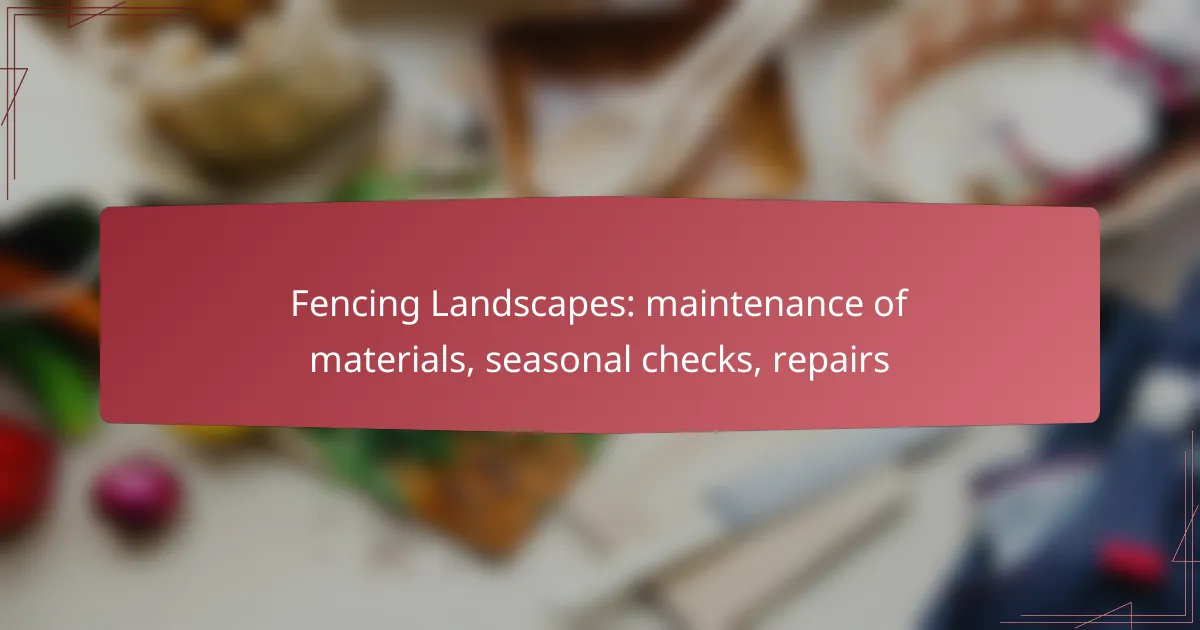Fencing landscapes require careful attention to the materials used, including wood, vinyl, chain link, composite, and metal, each offering unique benefits. Regular maintenance, including cleaning and protective treatments, is crucial for extending the lifespan of your fence and preserving its aesthetic appeal. Seasonal checks are essential to identify potential issues early, allowing for timely repairs and ensuring the fence remains functional and attractive throughout the year.

What are the best materials for fencing landscapes in Los Angeles?
The best materials for fencing landscapes in Los Angeles include wood, vinyl, chain link, composite, and metal. Each material has distinct characteristics that cater to different aesthetic preferences, durability needs, and budget considerations.
Wood fencing
Wood fencing is a popular choice for its natural appearance and versatility. Common types include cedar and redwood, which are resistant to decay and insects. Regular maintenance, such as staining or sealing, is essential to prolong its lifespan, especially in the sunny Los Angeles climate.
Consider the height and style of the wood fence, as well as local regulations that may dictate specific requirements. A well-maintained wood fence can last 15-20 years, but neglect can lead to quicker deterioration.
Vinyl fencing
Vinyl fencing offers a low-maintenance alternative to wood, with a variety of styles and colors available. It is resistant to fading, rotting, and pests, making it ideal for the Los Angeles area. However, it can be more expensive upfront compared to wood options.
Vinyl fences typically last over 20 years and require minimal upkeep, such as occasional cleaning with soap and water. Ensure that the installation follows local building codes for durability and safety.
Chain link fencing
Chain link fencing is a cost-effective and durable option, often used for security and boundary marking. It is made of galvanized steel, which resists rust and corrosion, making it suitable for the varied weather in Los Angeles.
This type of fencing is easy to install and maintain, but it may not provide the aesthetic appeal of other materials. Adding privacy slats can enhance its appearance while still keeping costs low.
Composite fencing
Composite fencing combines wood fibers and plastic, offering the look of wood with enhanced durability. It is resistant to rot, insects, and fading, making it a practical choice for Los Angeles homeowners seeking longevity.
While composite fences can be pricier than wood, their low maintenance requirements and lifespan of 25 years or more can justify the investment. Check for warranties that cover fading and structural integrity.
Metal fencing
Metal fencing, including aluminum and wrought iron, provides a strong and stylish option for security and aesthetics. Aluminum is lightweight and resistant to rust, while wrought iron offers a classic look but may require more maintenance to prevent corrosion.
Both types can last several decades with proper care. Consider local regulations regarding height and design, especially for wrought iron, which can be custom-designed for a unique appearance.

How to maintain fencing materials throughout the year?
Maintaining fencing materials year-round involves regular cleaning, protective treatments, and timely inspections. These practices help extend the lifespan of your fence and ensure it remains visually appealing and functional.
Regular cleaning
Regular cleaning is essential for maintaining fencing materials, as dirt and debris can lead to deterioration. Use a mild detergent and water solution to scrub surfaces, and rinse thoroughly to remove any residue.
For wooden fences, consider using a soft brush to avoid damaging the wood grain. For metal fences, a pressure washer can effectively remove stubborn grime, but ensure the pressure is set low to prevent surface damage.
Sealing and staining wood
Sealing and staining wood fences protects them from moisture and UV damage. Aim to apply a sealant or stain every one to three years, depending on your climate and the product used.
Choose a high-quality, water-repellent sealant that suits your wood type. This not only enhances the wood’s appearance but also prevents warping and cracking, which can occur due to exposure to the elements.
Inspecting for damage
Regular inspections for damage are crucial to maintaining the integrity of your fence. Check for signs of rot, rust, or loose boards at least twice a year, ideally in spring and fall.
Look for any areas where pests may have compromised the material. Early detection allows for timely repairs, which can save you from more extensive and costly fixes later on.
Repairing rust on metal
Repairing rust on metal fences is vital for preventing further deterioration. Start by removing rust with a wire brush or sandpaper, ensuring you wear protective gear to avoid injury.
After cleaning the area, apply a rust-inhibiting primer followed by a weather-resistant paint to protect against future rust. Regular maintenance, including inspections and touch-ups, can significantly extend the life of your metal fencing.

What seasonal checks should be performed on fences?
Seasonal checks on fences are essential for maintaining their integrity and appearance. Regular inspections help identify issues early, ensuring that repairs can be made before they escalate into more significant problems.
Spring inspections
In spring, inspect your fence for any winter damage, such as broken boards or loose posts. Look for signs of rot or rust, especially in wooden and metal fences, respectively. This is also a good time to check for any vegetation that may have grown too close, as it can cause structural issues over time.
Consider tightening any loose hardware and replacing any damaged components. A thorough spring inspection sets the stage for effective maintenance throughout the year.
Summer maintenance
During summer, focus on cleaning and treating your fence. Remove dirt, debris, and any plant growth that can lead to decay. For wooden fences, applying a protective sealant or stain can help prevent moisture damage and UV fading.
Check for any signs of insect infestations, particularly in wooden structures. Addressing these issues promptly can save you from costly repairs later on.
Fall preparations
As fall approaches, prepare your fence for the winter months. Inspect for any damage that may have occurred during the summer and make necessary repairs. This is an ideal time to reinforce posts and ensure that gates are functioning properly.
Consider applying a fresh coat of paint or sealant to protect against harsh winter conditions. Clearing away fallen leaves and debris will also help prevent moisture buildup, which can lead to rot.
Winter protection
In winter, focus on protecting your fence from snow and ice. Regularly remove heavy snow accumulation to prevent bending or breaking. If you have a wooden fence, ensure that it is adequately sealed to prevent moisture absorption.
Monitor for ice formation around posts and gates, as this can cause damage. If possible, create a barrier around your fence to shield it from harsh winds and heavy snowfall.

How to repair common fencing issues?
Repairing common fencing issues involves identifying the problem and taking appropriate steps to fix it. Regular maintenance and timely repairs can extend the life of your fence and enhance its appearance.
Fixing loose panels
Loose panels can compromise the stability of your fence. To fix them, check the fasteners and tighten any screws or nails that may have come loose. If the panel is damaged, consider replacing it with a new one that matches the existing fence.
For wooden panels, ensure that the wood is not rotting; if it is, replace the affected sections. Regularly inspect the panels, especially after severe weather, to prevent further issues.
Replacing broken posts
Broken posts are a common issue that can lead to a sagging or unstable fence. To replace a broken post, first remove the damaged post by digging it out of the ground. Ensure the hole is deep enough for the new post, typically one-third of its length.
Use concrete to secure the new post in place, allowing it to set properly before reattaching the panels. Check local regulations regarding post height and materials to ensure compliance.
Addressing leaning fences
A leaning fence often indicates a problem with the posts or the ground around them. To correct this, assess the base of the leaning post and determine if it needs to be reset or replaced. If the soil is eroding, consider adding gravel or soil to stabilize the area.
Reinforcing the leaning post with braces can provide immediate support while you make permanent repairs. Regular inspections can help catch leaning issues early before they become more severe.
Repairing gates
Gates can become misaligned or difficult to open over time. Start by checking the hinges for wear and tightening any loose screws. If the gate is sagging, you may need to adjust the hinges or add a support brace to keep it level.
For wooden gates, inspect for rot or damage and replace any affected boards. Ensure that the latch mechanism is functioning properly and consider lubricating it to maintain smooth operation.

What permits are needed for fencing installation in California?
In California, installing a fence typically requires a building permit, especially for structures over a certain height or in specific zones. Local regulations may vary, so it’s essential to check with your city or county planning department for precise requirements.
Building permits
Building permits are often necessary for fencing projects that exceed six feet in height or are located in certain areas, such as near property lines or in historic districts. The application process usually involves submitting plans that detail the fence’s design, materials, and location.
To obtain a building permit, you may need to provide documentation such as property surveys, site plans, and possibly even neighbor notifications. Fees for permits can vary widely, typically ranging from $50 to a few hundred dollars, depending on the jurisdiction and project scope.
It is advisable to apply for permits before starting any work to avoid fines or the need to remove an unpermitted fence. Always consult local regulations to ensure compliance and streamline the installation process.



